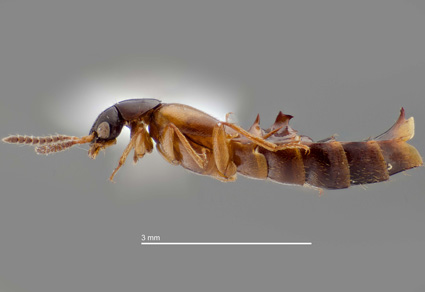Abstract
Ctenopeuca Bernhauer is a genus restricted to South America, with males exhibit bimodal secondary sexual characters with alpha males having large abdominal spines and feminized spine-less beta males. In contrast to other Oxypodini genera, Ctenopeuca lacks a frontal suture on the head and has a bifid ligula. Here, we redescribe the genus and the two species, provide a diagnosis for the genus, and make remarks about its systematic position within the Oxypodini.
References
- Asenjo, A., Irmler, U., Klimaszewski, J., Chandler, D.S., Fierros-López, H.E. & Vieira, J.S. (2019) Staphylinidae (Insecta: Coleoptera) in Latin America: synopsis, annotated catalog, diversity and distribution. Zootaxa, 4621 (1), 1–406. https://doi.org/10.11646/zootaxa.4621.1.1
- Bernhauer, M. (1908) Beitrag zur Staphylinidenfauna von Südamerika. Archiv für Naturgeschichte, 74, 283–372.
- Bernhauer, M. (1915) Zur Staphyliniden-Fauna von Südamerika. Stettiner Entomologische Zeitung, 76, 291–301. https://doi.org/10.1002/mmnd.191519150207
- Bernhauer, M. (1928) Neue Staphyliniden aus der Ausbeute der schwedischen Amazonasexpeditionem. Entomologisk Tidsrift, 49, 45–47.
- Bortoluzzi, S. & Caron, E. (2014) The unique Brazilian species of Polylobus Solier (Coleoptera: Staphylinidae: Aleocharinae) with a checklist of all species of the genus. Zootaxa, 3811 (2), 226–238. https://doi.org/10.11646/zootaxa.3811.2.4
- Eberhard, W.G. (1982) Beetle horn dimorphism: making the best of a bad lot. The American Naturalist, 119, 420–426. https://doi.org/10.1086/283920
- Emlen, D.J. (1994) Environmental control of horn length dimorphism in the beetle Onthophagus acuminatus (Coleoptera: Scarabaeidae). Proceedings of the Royal Society B, 256, 131–136. https://doi.org/10.1098/rspb.1994.0060
- Gaedike, R. (2023) Roman, Emile. Available from: https://sdei.senckenberg.de/biographies/index.php (accessed 20 October 2023)
- Hanley, R.S., Ashe, J.S. (1998) A new genus and species of aleocharine rove beetle (Coleoptera Staphylinidae Aleocharinae Hoplandriini) from the New World. Tropical Zoology, 11, 183–191. https://doi.org/10.1080/03946975.1998.10539360
- Klimaszewski, J. & Sturm, H. (1991) Four new espéciess of the Oxypodine genus Polylobus Solier (Coleoptera: Staphylinidae: Aleocharinae) collected on the flower heads of some high Andean giant rosette plants (Espeletiinae: Asteraceae). The Coleopterists Bulletin, 45, 1–13.
- Klimaszewski, J., Brunke, A., Sikes, D.S., Pentinsaari, M., Godin, B., Webster, R.P., Davies, A., Bourdon, C. & Newton, A.F. (2021) Tribe Oxypodini C.G. Thomson, 1859. In: A Faunal Review of Aleocharine Beetles in the Rapidly Changing Arctic and Subarctic Regions of North America (Coleoptera, Staphylinidae). Springer, Cham, pp. 183–274. https://doi.org/10.1007/978-3-030-68191-3_11
- Moczek, A.P. & Emlen, D.J. (2000) Male horn dimorphism in the scarab beetle, Onthophagus taurus: do alternative reproductive tactics favour alternative phenotypes? Animal Behaviour, 59 (2), 459–466. https://doi.org/10.1006/anbe.1999.1342
- Neff, B.D. & Svensson, E.I. (2013) Polyandry and alternative mating tactics. Philosophical Transactions of the Royal Society B, 368, 20120045. https://doi.org/10.1098/rstb.2012.0045
- Newton, A. (2022) StaphBase. In: Bánki, O., Roskov, Y., Döring, M., Ower, G., Hernández Robles, D.R., Plata Corredor, C.A., Stjernegaard Jeppesen, T., Örn, A., Vandepitte, L., Hobern, D., Schalk, P., DeWalt, R.E., Ma, K., Miller, J., Orrell, T., Aalbu, R., Abbott, J., Adlard, R., Adriaenssens, E.M. et al., Catalogue of Life Checklist. August 2022. https://doi.org/10.48580/dfsr-3gk
- Newton, A.F., Thayer, M.K., Ashe, J.S. & Chandler, D.S. (2000) 22. Staphylinidae. In: Arnett, R.H. & Thomas, M.C. (Eds.), American Beetles. Vol. 1. Archostemata, Myxophaga, Adephaga, Polyphaga: Staphyliniformia. CRC Press, Boca Raton, London, New York and Washington, pp. 272–418.
- Orlov, I., Lescgen, R.A.B., Zyla, D. & Solodovnikov, A. (2021) Total-evidence backbone phylogeny of Aleocharinae (Coleoptera: Staphylinidae). Cladistics, 37, 343–374. https://doi.org/10.1111/cla.12444
- Osswald, J., Bachmann, L. & Gusarov, V. (2013) Molecular phylogeny of the beetle tribe Oxypodini (Coleoptera: Staphylinidae: Aleocharinae). Systematic Entomology, 38, 507–522. https://doi.org/10.1111/syen.12081
- Pace, R. (1990) Nuovi Falagriini, Hoplandriini ed Aleocharini della Regione Neotropica (Coleoptera, Staphylinidae) (LXXX contributo alla conoscenza delle Aleocharinae). Giornale Italiano di Entomologia, 5, 157–180.
- Pace, R. (2008) New records of Aleocharinae from Ecuador and Peru, with the description of new species, new subgenera and new genera (Coleoptera, Staphylinidae). Biodiversity of South America I. Memoirs on Biodiversity, 1, 225–398.
- Pace, R. (2009) Nuovi dati faunistici e tassonomici su Aleocharinae delle tribù Lomechusini, Hoplandriini, Oxypodini e Aleocharini del Sudamerica. Beiträge zur Entomologie, 59, 133–173. https://doi.org/10.21248/contrib.entomol.59.1.133-173
- Reflora (2023) Aristolochiaceae in Flora e Funga do Brasil. Jardim Botânico do Rio de Janeiro. Available from: https://floradobrasil.jbrj.gov.br/FB15749 (accessed 18 October 2023)
- Schubert, E. (2023) Heyne, Alexander. https://sdei.senckenberg.de/biographies/index.php (accessed 20 October 2023)
- Seevers, C.H. (1978) A generic and tribal revision of the North American Aleocharinae (Coleoptera: Staphylinidae). Fieldiana, Zoology, 71, i–vi + 1–289.
- Shuster, S.M. (1989) Male alternative reproductive strategies in a marine isopod crustacean (Paracerceis sculpta): the use of genetic markers to measure differences in fertilization success among a-, b-, and g-males. Evolution, 43, 1683–1698. https://doi.org/10.2307/2409384
- Shuster, S.M. & Wade, M.J. (1991) Equal mating success among male reproductive strategies in a marine isopod. Nature, 350, 608–610. https://doi.org/10.1038/350608a0


